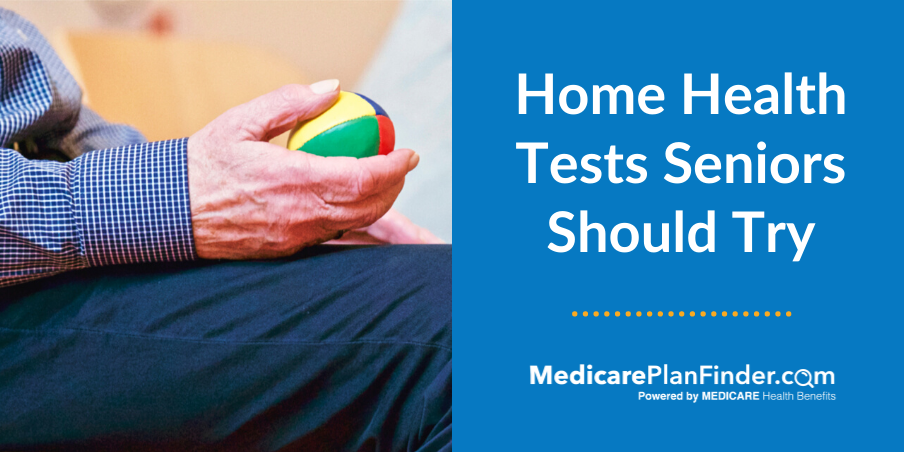
Home Health Tests Seniors Should Try
November 4, 2019We’re all aware we should make an effort to regularly see our physicians. But we also know that life tends to get in the way.
Especially for seniors, transportation and cost can often prevent routine doctor visits. However, just because you can’t get to your doctor’s office, doesn’t mean you have to stay in the dark about your health. There are quite a number of tests that you can perform without ever leaving home!
Tests You Can Do At Home Today
The range of at-home tests and testing methods varies widely. Some require expensive medical equipment only available through a supplier and with a prescription, while others require only a pen and paper. Here are some tests that you can do today with little to no supplies
SAGE Test for Dementia
The Self-Administered Gerocognitive Exam, or SAGE, was devised by researchers from the Wexner Medical Center at Ohio State University. SAGE can help detect early warning signs of cognitive impairment and memory loss in less than 15 minutes.
The test has several components and several forms, all of which can be viewed and downloaded at the Wexner Medical Center’s website. These include sections on orientation, language, memory and visuospatial awareness.
The most well-known element of the SAGE is known as the clock drawing test. All you need to do is get out a pen and paper and draw a picture of a clock, with the hands reading 3:40. Then compare your drawing to a real clock to see how you scored.
If your circle is closed, give yourself a point. If all twelve numbers are accounted for and in the right place, you get two more points. If your hands are in the correct position as well, you passed with flying colors. A score of any less than three points, however, might be an indication that you should see your physician for further screening. This test is sometimes performed without the rest of the exam, though it is usually recommended to perform the entire SAGE test for dementia detection.

Window Test for Vision Loss
Our eyes take a lot of abuse these days from the onslaught of screens and artificial lighting. It’s even more severe as we get older and the natural, age-related loss of vision begins to take effect. If you experience some trouble reading, give yourself this informal at-home eye exam to judge whether or not you should seek an eye care professional.
First, sit across the room from a large window or door so that you can see all the lines of the frame around it. Cover one eye and focus on the window or door frame with your open one for 30 seconds. Then repeat with the opposite eye. The horizontal and vertical lines of the frame should be clearly visible with no missing or hazy areas. If the edges of the frame seem distorted or warped, this may indicate macular degeneration, a disease that is currently the leading cause of irreversible vision loss in people over 60.
Cushion Test for Peripheral Arterial Disease
The cushion test can be performed without even getting out of bed! It can help detect blocked arteries in your legs and feet, a condition known as PAD, or peripheral arterial disease. Those with high blood pressure or diabetes, both common among seniors, are especially at-risk for this disease.
To perform this test, lie on a bed and elevate your legs with pillows or cushions until they are resting at a comfortable 45-degree angle. Keep them there for one minute, then sit up and swing your legs over the side of the bed so that they hang at an angle of 90 degrees. If either or both of your legs turn pale when elevated and take several minutes to return to their normal shade after sitting up, you may need to consult your physician with the results from this peripheral artery disease test.
Phalen’s Maneuver for Carpal Tunnel
We are an increasingly computer-savvy society and people of all ages are typing more than they used to. Extended periods of typing are strongly associated with carpal tunnel syndrome, a painful condition caused by a pinched median nerve in the wrist, but many other activities like driving can bring on these symptoms as well. Furthermore, people over 55 years old are at a much higher risk and those over 65 are more likely to have cases that are severe.
Phalen’s maneuver is a test devised to diagnose carpal tunnel at home and has been shown to be surprisingly effective. To see for yourself, press the tops of your hands together with your fingers pointing toward the floor and your elbows extended. If you can, hold this position for a full minute. If you feel an unpleasant sensation, such as prickling, tingling, or burning, you may likely have carpal tunnel and should consider preventive measures.
Check out this video from Physiotutors on YouTube that explains how to perform the Phalen test:
Testing With Medical Equipment
Some at-home health tests will require special instruments to fully gauge the results. While many of these items can be freely obtained from online and brick-and-mortar retailers, some require ordering through a medical supplier with a doctor’s prescription. Below, we will detail some of the testing you can do at home with the help of specially-designed medical equipment.
Blood Sugar Test
For the 12 million seniors living with diabetes* (about 25% of those over the age of 65), monitoring blood sugar levels is an near-constant concern. Luckily, this is something that can be checked at home or on-the-go using a blood glucose monitor, or glucometer. These can be found online or in pharmacies in the form of kits, which include testing strips, needles (called lancets), and the glucometer itself.
Read about Medicare coverage for Diabetes!
To test blood sugar at home, you will need to insert a test strip into the electronic monitor and prick the side of your finger with the provided lancet. Gently apply pressure to that finger until you see a drop of blood form, then touch it to the edge of the test strip. In just a few seconds, you will have an accurate metering of your current blood sugar levels, no matter where you are.
Blood Pressure Test
Along with heart rate, breathing rate, and body temperature, blood pressure is one of the four most significant vital signs that our bodies produce. High blood pressure can be caused by countless factors like high cholesterol, stress, and even fear, and affects almost 70% of adults between the ages of 65 to 74. Monitoring blood pressure accurately is vitally important, as symptoms may not manifest until these levels are dangerously high. Doctors maintain accuracy by using large, costly machines but there are ways to test blood pressure at home with minimal equipment.
The quickest and most accurate results will come from automated, electronic blood pressure monitors that come with an upper arm cuff. Many different brands of at-home blood pressure cuff exist and can be found at pharmacies or similar retailers. The directions for use may change from model to model but there are certain rules that apply no matter what brand you use, including placing the cuff directly on the skin, placing the feet flat on the floor, elevating the arm to chest height, and avoiding smoking or drinking for 30 minutes before testing.
At-Home Lab Tests
Another popular method of in-home health testing comes in the form of test kits that can be ordered right to your door. These vary widely, not only in terms of what is being tested, but also in the method of sample collection. Some services will send a team of professionals to administer and retrieve your test, while others will only send instructions and require you to send your samples back in the mail for results. These can be purchased to test for a wide range of conditions, including food sensitivity, hormone testing, DNA testing, and other at-home blood tests.
Medicare DME Coverage

Durable medical equipment, or DME, is a designation that Medicare uses to classify coverable medical equipment that can be used in the home. This benefit might be used to cover the cost of equipment to aid in the at-home testing we have already covered. The covered equipment can range from crutches and canes to CPAP devices and hospital beds, though it all must come from a Medicare-approved medical supplier.
Medicare-Approved Glucose Meters
Blood sugar monitors and test strips are usually covered under Medicare Part B as durable medical equipment for home use with a doctor’s prescription. You may be able to rent or buy a glucometer but Medicare will only provide coverage if both your physician and the supplier are both enrolled and participating in Medicare. Be sure to clarify this with your doctor and equipment supplier, as some may be enrolled but not “participating” and may not accept the cost of assignment.
Read more about durable medical equipment Medicare coverage.
Does Medicare Cover Blood Pressure Monitor?
Medicare Part B may cover the cost of a blood pressure monitor or ambulatory blood pressure monitoring (ABPM) device but only under very specific circumstances. Part B will cover a blood pressure monitor and stethoscope for those who receive blood dialysis treatment in their home and will pay for the rental of an ABPM device for patients who have exhibited “white coat hypertension,” a phenomenon where nervousness in clinical settings causes artificially high blood pressure readings.
For those with Medicare Part C, or Medicare Advantage, all the benefits of Parts A & B will be covered but may also include additional benefits and expanded coverage. Contact your insurance company to find out if your Part C plan covers blood pressure monitors or glucometers.
If you don’t have a Medicare Advantage plan, give us a call at 844-431-1832 or contact us online to speak with a licensed agent and find a plan that can address your healthcare needs!


